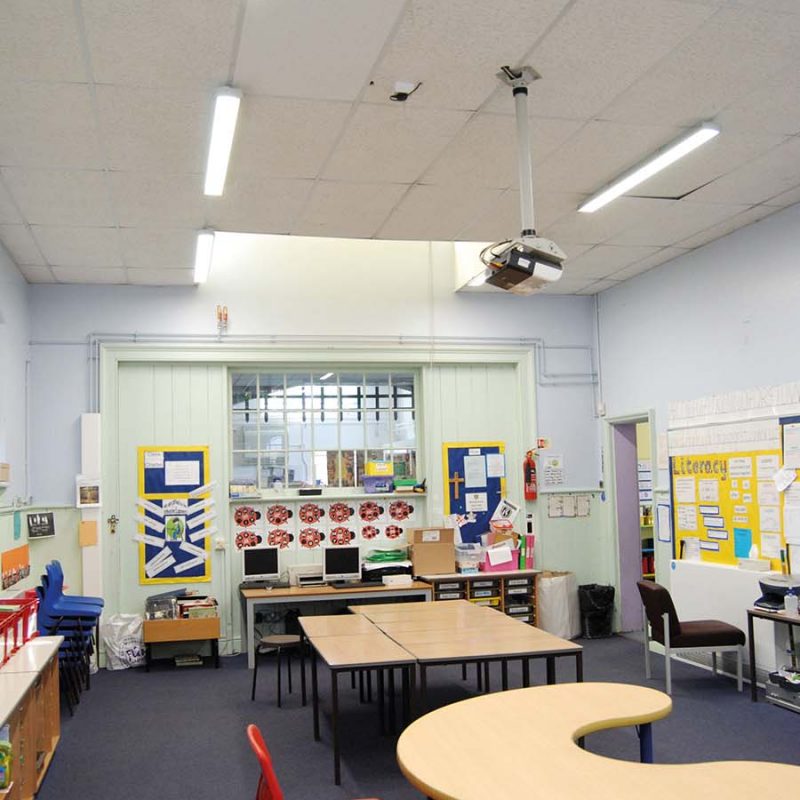With financial savings, adaptability to all types of facilities a school building has to offer, and the opportunity to adopt human-centric lighting systems that enhance psychological wellbeing, what’s not to love? Saima Shafi, Sales and Marketing Director at Goodlight, reports.
Goodlight
Too many schools and colleges are still settling for flickering fluorescent lights which contain harmful mercury gases, cause migraines and produce a yellow or orange tinge which reduces student productivity. Through Goodlight’s own projects in the education sector, we’ve seen first-hand how LED lighting solutions for schools and universities can aid learning throughout the academic day, so much so that it’s worth emphasising the reasons why it can have a positive impact on pupils and teachers.
Financial matters
Firstly, the dramatic reduction in school budgets through decreased energy usage and virtually non-existent maintenance overheads is a very strong argument for installing LED lighting solutions. Budget constraints are a common reason why school facilities managers will reject any dramatic changes to the building’s existing systems. However, we helped Writtle College in Essex achieve almost £18,000 in annual energy savings with an installation of Goodlight retrofit LED lighting, including T8 tubes, ceiling panels, 2D lamps and 5ft twin fittings, into the college building. This massive saving, plus reduced maintenance costs, equates to a very positive ROI with the initial £57,000 investment being repaid in just over three years and more than £191,000 saved during the lifespan of the installation.
Automated systems
Coupling LED luminaires with an intelligent SMART lighting control system, such as Light Boss, could considerably enhance the cost-saving benefits outlined above. Automated systems can turn on or dim lights according to changes in light, occupancy or time of day. Operating your lighting where it is needed – rather than at 100% brightness constantly – not only minimises energy consumption but extends lighting lifecycles and reduces maintenance costs. Typical energy savings, when combined with Goodlight LED luminaires are between 60 to 95%. SMART lighting control is central in achieving lowered operation costs, improved energy savings, and enhanced security. In addition, the swift and simple installation of these systems accommodates the short closure period outside term time, the only time when large building changes can take place.
Suitable for all spaces
As well as accommodating the needs of the school term times, LED lighting also accommodates the wide range of facilities housed by a school or college building – classroom, office and sports hall to name a few. Each space has unique lighting demands to be met, and fortunately, the versatility of LED lighting can meet all these applications. The building requires the full range of daytime to nighttime lighting as it needs to be illuminated in the evenings too – for example, parent’s evenings, after-school clubs and other activities inside or outside – to ensure safety within the school. School exteriors including classroom exteriors, play areas, car parks and pathways should be illuminated for pupils, teachers and parents to ensure safety around the school. The visibility needs to be clear so that teachers who start work early can walk safely and easily into school, especially in the colder months when the clocks go back and the daylight hours are shorter. Adequate illumination is also required for parents, guardians, pupils and visitors, especially in the darker, winter months. LED floodlights are perfect for this, and our Goodlight LED floodlights deliver 110Lm/W to illuminate a school exterior beautifully without the need for metal halide or halogen lights. As another example, school sports halls can also be given a new lease of light with LED high bay lights. The Goodlight GX1 LED high bay is an IP65-rated luminaire which can be installed from 6m and features a super-bright light output of 125Lm/W. We have also installed our LED high bays in the Royal Ballet School’s dance studio in London, providing superb quality light along with impressive cost savings.
Human-centric lighting
Aside from practicalities, there also are psychological benefits to LED lighting installations in schools. LED lighting can be human-centric, meaning it adjusts throughout the day, which has been proven to benefit pupil and teacher performance by improving concentration, productivity and mood. It also has a positive impact on pupil behaviour.
Human beings are tuned-in to daily cycles of light and darkness, which give us our cues of when to sleep and wake. Particularly during the dark winter months, the early start of the school day can be a struggle for both teachers and pupils as the long periods of low light disrupt the body clock. Human-centric lighting, which mimics the complex effect of natural daylight through different hues and intensities, can counter this physiological disruption.
When installed in a school facility, a typical LED lighting set-up delivers cool white and intensive light for the first part of the day, which adjusts production of stress and sleep hormones in pupils and teachers, before shifting their daily rhythms forward to making everyone more active during the early part of the school day. Later, a focus light enhances concentration on tasks through cool white and intensive light. When it’s time to relax, a warmer white light creates the right atmosphere. Aside from improvements in general concentration, human-centric lighting also reduces the symptoms of ADHD and counteracts the negative effects of artificial light absorbed from screens or smart boards.
In conclusion, an education facility needs to be a safe, focused, welcoming and carefully maintained environment – all of which can be enhanced through human-centric lighting, achieved by LED lighting installations. The benefits of this technology to schools and colleges are undeniable and set to benefit the next generation of pupils and teachers. In short, the future for education facilities looks bright.









